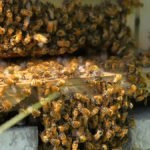There are times of the year, and races of bees that will need an entrance reducer to stop robbing, keep cold air out, keep rats and mice out, and a whole myriad of other things. Beehive entrance reducer dimensions are important to help you maximize the efficiency of this piece of hive equipment.
What Are Entrance Reducers and What Are The Optimal Beehive Entrance Reducer Dimensions?
If we look at a normal brood box or even a nucleus box, the entrance consists of quite a bit of open space that the bees can fly in and out of. There are times when a hive is a bit weak, or if it is cold when it can be useful to reduce the size of the entrance. This is what an entrance reducer is for. Beehive entrance reducer dimensions are important to allow you to achieve the management options you wish to achieve.
How Do You Make A Hive Entrance Reducer?
There are many ways to make a reducer. This will depend on the hive that you have. Measure the size of the entrance, and cut a piece of wood to fit the entrance. I normally try to make my life as simple as possible, hence the entrance reducers I use consist of a few pieces of wood that I can slot into the entrance of my hive to reduce the overall length of the entrance. If you cut a few pieces of wood which are 5 inches long, you can slot these into the hive entrance and leave an inch or two between the pieces which will be the new reduced entrances.
The beehive entrance reducer dimensions are really determined by the entrance size of your hive. We find that Langstroth hives tend to have pretty standard dimensions (they must) on the boxes, and frames, but I do find that the bottom boards, entrance sizes and so on seem to be an area where manufacturers exercise imagination.
Bees are actually quite good at adjusting the size of an entrance with little help from us. We just help out a bit until they can make their own arrangements. Bees adjust the entrance with propolis – if you are keeping a race that has had the ability to gather propolis bred out of it, such as some Italian strains, you may need to pay a bit more attention to entrance reducers.
When Should A Beehive Use An Entrance Reducer?
I must highlight at this point that I am answering actual questions asked exactly as they have been asked. The above question (sorry question asker) is dramatically confusing and should read more like “When should we use an entrance reducer on a beehive?”
We use beehive entrance reducers at times when the bees cannot defend the entrance or are unable to stop breezes blowing into the entrance. There are times in autumn when entrance reducers can also help the bees defend against yellow jackets. I have found that there are times when small mice and other irritating creatures can crawl into beehives. Sometimes I use an entrance reducer. Years ago, my friend who is an IT guy was showing me his cable stapler – this actually is an incredibly useful device for reducing hive entrances so that mice and snakes cannot crawl into the hive in temperate areas such as mine.
What Size Should The Beehive Entrance Be?
This is really a case-by-case situation. The right hive dimension for a dry apiary hive entrance in an arid region is completely different from what is needed in a swamp in Florida. If you are running a single brood box hive with a single super in an arid region, the bees are easily able to remove humidity from the hive – and they can bring enough air in and out of the hive to keep it cool.
When you move to a humid swamp with two or more brood boxes and half a dozen supers the volume of air the bees have to move through the hive increases. The number of bees moving through the entrance also increases. The entrance configuration for your area is something you will work out with time. For me, in my area, I generally try to have two entrance slots that are about 5-6 inches long. The bees open and close these as needed with propolis once they are strong. Before that, a few staples help keep mice and snakes out.
Do You Need A Bee Entrance Reducer?
This is again a case-by-case answer. There are some areas and some races of bees where entrance reducers are important. If you are keeping African bees in Brazil or the Congo -no – you do not need an entrance reducer. The bees will make their own with propolis. If you are keeping Italian bees on the East Coast of the US and the Goldenrod honey flow has just come to an end, and yellow jackets are out in full force – you need an entrance reducer.
I find that most strong bees can sort out their own entrance dynamics if they have not been overly bred to be “light propolizers”. If you have bees that have been in a hive for five years and you can remove the frames by hand, without having to prize them with a hive tool – you need entrance reducers. If an old established hive has difficulty removing frames chances are the bees can figure out how to reduce their own entrance – they will just move some propolis out of the hive body to the hive entrance and close it up.
Beehive Entrance Reducer Dimensions
Let’s look at a few entrance reducers which are dimensioned and made for standard hives.
I have used these wooden ones such as this before. These are quite neat because you can just pull them out of the entrance and flip them around to create a different setting. One way around they give you a medium size entrance and the other way around they give you a little entrance. These do not last very long if there is propolis and with time they turn into a multi-part entrance reducer and eventually firewood.
An alternative, which is also more useful if you have non-standard bottom boards and need a slightly bigger entrance reducer is this option. I have not used this specific one, but a very similar design many years back that was made from metal. They are quite effective. You will find that under certain conditions these can become a problem if you get drones being reared in the hive – they can get blocked when the drones fly, so you do have to be vigilant in spring.

I hope this article has helped you understand more about beehive entrance reducer dimensions. Sadly there is no one size fits all entrance reducer, or answer to how to make them or the size they should be! In each area, your old wise beekeepers will have strongly held theories about what works. Listen to them. And also take what they say with a pinch of salt and adjust accordingly. Climates and ecosystems are in constant flux-what worked in 1970, 1990, or 2012 and what will work in 2022 will always be a little different. We adapt, we learn, we adjust. If you enjoyed this please share.
Read more about: Why Are Bees Clustering At The Hive Entrance?
FAQs
What is a beehive entrance reducer?
A beehive entrance reducer is a small piece of wood or metal used to control the size of the hive entrance. It helps protect the colony from pests, cold drafts, and robbing by other bees, especially during times of vulnerability like winter or nectar dearths.
Why are beehive entrance reducer dimensions important?
The dimensions determine how effectively the reducer can regulate airflow, prevent intruders like mice, and allow the bees to defend the entrance. Customizing the size based on the colony’s needs and environmental conditions is crucial for hive health.
When should I use an entrance reducer?
Entrance reducers are most useful in cold weather to retain heat, during robbing seasons to help bees defend the hive, and in areas where pests like mice might try to enter the hive. They’re also beneficial for weak colonies or new hives to control access.
How do I make a hive entrance reducer?
To make a hive entrance reducer, measure the width of your hive’s entrance and cut a piece of wood to fit snugly. You can create multiple pieces to adjust the entrance size. For standard Langstroth hives, a 5-inch piece is a common starting point.
Do all beekeepers need an entrance reducer?
No, not all beekeepers or colonies need entrance reducers. Strong colonies or bees in certain climates (like African bees in tropical regions) may not require a reducer. However, weaker colonies or bees in colder climates often benefit from one.
Can bees adjust the hive entrance without a reducer?
Yes, bees can use propolis to regulate the size of their entrance naturally. Some species, like African bees, are better at this than others, like certain strains of Italian bees, which may require more assistance from beekeepers.
What are the standard dimensions for a beehive entrance reducer?
The dimensions depend on the hive type, but for a Langstroth hive, a reducer typically allows for a 1-2 inch entrance during colder seasons. Some reducers are reversible, offering different-sized entrances depending on how they are positioned in the hive.
What are some alternative entrance reducers I can use?
Besides wooden reducers, some beekeepers use fabric or metal mesh to reduce the entrance. Metal reducers, while more durable, may cause blockages, especially when drones are present in spring, so beekeepers must monitor their use.

Dr. Garth A. Cambray is a Canadian/South African entrepreneur and beekeeper with 28 years of experience in apiculture and specializes in adding value to honey. His Ph.D. research developed a new advanced continuous fermentation method for making mead that has resulted in a number of companies globally being able to access markets for mead. His company, Makana Meadery, exports honey mead to the USA where it is available to discerning connoisseurs. He has also developed technologies to commercially manufacture organic honey vinegar in Zambia for export globally. He holds a few patents globally in the ethanol industry and believes in technology and knowledge transfer for human development and environmental sustainability. One of his proudest achievements is the fact that the wind farm he started at one of his old apiary sites has essentially made his hometown carbon neutral.






